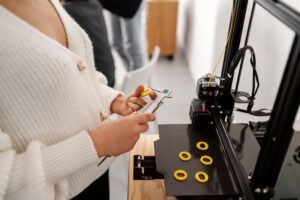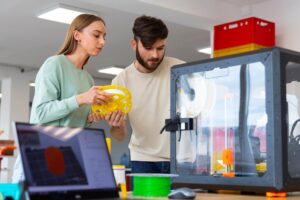The Renaissance of Creation: Unveiling the Boundless Horizons of Personal Fabrication in the Era of Consumer 3D Printing
Definition of Personal Fabrication: Empowering Individuals with the Tools of Creation
In today’s ever-evolving technological landscape, personal fabrication has emerged as a groundbreaking concept that empowers individuals to become creators, designers, and innovators in their own right. At its core, personal fabrication refers to the process of utilizing advanced technologies such as 3D printing to manufacture physical objects and prototypes on a small scale, often within the comfort of one’s own home or workspace.
This revolutionary approach represents a paradigm shift from traditional manufacturing models where production was limited to large-scale factories and relied heavily on mass production techniques. Instead, personal fabrication places the power of creation directly into the hands of individuals by democratizing access to cutting-edge tools and technologies.
Overview of Consumer 3D Printing: A Technological Marvel in Every Home
At the forefront of personal fabrication lies consumer 3D printing – a technology that has captured the imagination of enthusiasts, professionals, and hobbyists alike. Consumer 3D printers are compact devices that utilize additive manufacturing techniques to transform digital designs into physical objects layer by layer. With diverse printing methods such as Fused Deposition Modeling (FDM), Stereolithography (SLA), and Selective Laser Sintering (SLS), these machines are capable of fabricating objects using various materials ranging from plastics like ABS or PLA to metals like titanium or stainless steel.
Consumer-grade 3D printers have experienced exponential growth in accessibility and affordability over recent years. Once confined within research institutions or industrial settings due to their high costs, these powerful machines can now be found in homes, schools, and small businesses worldwide.
Moreover, advancements in software development have made designing for 3D printing more user-friendly than ever before. Intuitive interfaces coupled with an abundance of online resources ensure that even beginners can quickly grasp the intricacies of creating their designs, thus making consumer 3D printing a truly democratized technology.
Importance of Personal Fabrication in Shaping the Future: Revolutionizing Manufacturing and Beyond
The rise of personal fabrication through consumer 3D printing signifies a transformative shift in the way we approach manufacturing and creativity. This technological phenomenon holds immense potential to reshape numerous industries, stimulate innovation, and redefine societal norms. By granting individuals the ability to fabricate custom-made objects on-demand, personal fabrication has the power to disrupt traditional supply chains by reducing reliance on mass production, transportation costs, and wasteful overproduction.
Furthermore, personal fabrication promotes a culture of entrepreneurship and ingenuity by empowering individuals to transform their ideas into reality. By eliminating conventional barriers to entry in manufacturing – such as high capital investments or complex production processes – this technology enables aspiring inventors and entrepreneurs to bring their unique concepts directly to market.
Personal fabrication represents more than just a technological advancement; it is a catalyst for social change that encourages creativity, customization, environmental sustainability, and economic empowerment. As we delve deeper into the intricacies of this transformative concept, we will uncover its applications across various industries and explore how it shapes our collective future.

The Evolution of 3D Printing Technology
Historical Background of Additive Manufacturing
The concept of additive manufacturing, known today as 3D printing, traces its origins back to the early 1980s. Charles Hull, often referred to as the “father of 3D printing,” invented stereolithography—a process that used laser technology to solidify layers of liquid photopolymer resin, giving birth to the first-ever 3D printer.
This groundbreaking development revolutionized traditional manufacturing methods by enabling the creation of complex three-dimensional objects from digital designs. Over time, this nascent technology evolved and expanded its reach across various industries, setting the stage for a new era in fabrication.
Advancements in Materials and Techniques
As consumer interest grew and demand surged for more diverse applications, significant advancements in materials and techniques propelled the evolution of 3D printing technology. Initially limited to plastics and polymers, the range of printable materials has expanded exponentially.
Today, it encompasses metals like titanium and aluminum alloys for industrial purposes; ceramics such as porcelain or zirconia for dental or artistic applications; biocompatible materials like hydrogels for medical innovations; even food-grade ingredients allowing culinary experimentation. Furthermore, novel techniques like Selective Laser Sintering (SLS), Fused Deposition Modeling (FDM), Stereolithography (SLA), among others, have emerged—each offering distinct advantages suited to particular requirements.
Introduction to Different Types of 3D Printers (FDM, SLA, SLS)
To fully comprehend the scope and versatility of personal fabrication through consumer-grade technologies, it is essential to explore different types of 3D printers available today. One popular type is Fused Deposition Modeling (FDM), which works by extruding thin layers of thermoplastic filament that then solidify to form the desired object. SLA, or Stereolithography Apparatus, on the other hand, employs a laser to cure resin layer by layer, resulting in highly detailed, smooth prints.
Selective Laser Sintering (SLS) utilizes a laser to fuse powdered materials together to create intricate and robust objects. Each technique has unique features and applications that cater to different needs, underscoring the versatility of consumer 3D printing.
Exploration of Various Printable Materials (Plastics, Metals, Ceramics)
The variety of materials compatible with 3D printing has expanded beyond traditional plastics. Polylactic acid (PLA) and acrylonitrile butadiene styrene (ABS) are still widely used due to their accessibility and ease of use with FDM printers. However, advancements have spurred the inclusion of high-performance polymers like polyetheretherketone (PEEK) or nylon for more demanding applications.
Concurrently, metal 3D printing has gained significant traction in industries such as aerospace and automotive engineering. Using techniques like Direct Metal Laser Sintering (DMLS), engineers can fabricate intricate metal parts with excellent strength and thermal properties.
The introduction of ceramic materials into the realm of 3D printing provides opportunities for dental prosthetics and customized design elements in architecture or art installations. This expanding range of printable materials opens up endless possibilities for creativity across numerous fields.
Impact on Industries and Society at Large
The impact of 3D printing technology extends far beyond its technological capabilities—it is transforming industries fundamentally while igniting societal shifts as well. Manufacturing processes are becoming decentralized as small-scale production becomes economically viable through additive manufacturing techniques.
This decentralization empowers individuals and businesses alike by reducing costs associated with mass production while enabling customization at an unparalleled level. Additionally, sectors such as healthcare have witnessed groundbreaking advancements through 3D printing, including personalized prosthetics and medical implants.
The accessibility and democratization of fabrication have also nurtured a thriving community of makers, artists, and innovators who are actively pushing the boundaries of what is possible. This convergence of technology and creativity holds tremendous promise for shaping a future where everyone can become a creator.

The Rise of Consumer 3D Printing
Accessibility and Affordability for Individuals
Consumer 3D printing has revolutionized the manufacturing landscape by making this once-exclusive technology accessible to individuals across a wide range of backgrounds. One of the key factors driving the rise of consumer 3D printing is the decreasing costs associated with acquiring a consumer-grade printer.
In recent years, advancements in technology and economies of scale have led to a significant reduction in prices, making these devices much more affordable for the average person. Furthermore, an increasing number of companies have entered the market, offering a diverse range of printers at different price points to cater to various budgets.
User-Friendly Software and Design Tools for Beginners
Another crucial element that has propelled consumer 3D printing forward is the development of user-friendly software and design tools specifically tailored for beginners. In the early days, creating 3D models required extensive knowledge of computer-aided design (CAD) software, which acted as a barrier for many aspiring creators.
However, with advancements in software interfaces and intuitive design tools, even those without prior experience can now easily generate complex objects or modify existing designs to suit their needs. These user-friendly interfaces often include drag-and-drop functionalities, pre-designed templates, and simplified tools that enable novices to experiment with creativity effortlessly.
Some platforms even provide tutorials or step-by-step instructions on how to use them effectively. By reducing entry barriers through intuitive software solutions, consumer 3D printing has empowered individuals who were previously excluded from traditional manufacturing processes.
Empowering Individuals to Become Creators
One of the most profound implications of consumer 3D printing is its ability to empower individuals as creators rather than mere consumers. This transformative technology allows people to take an active role in shaping their physical environment by enabling them to manufacture objects according to their specific needs or preferences. With consumer-grade 3D printers, individuals can move beyond the limitations imposed by mass-produced products and embark on a journey of customization and personalization.
This empowerment goes beyond a simple act of manufacturing; it fosters a creative mindset that encourages exploration, innovation, and entrepreneurship. By providing tools and opportunities for individuals to bring their ideas to life, consumer 3D printing sparks a sense of ownership over the physical objects in our lives.
This newfound agency has far-reaching implications for various industries, from art and design to engineering and manufacturing. As people embrace their role as creators in this rapidly evolving landscape, the full potential of consumer 3D printing will continue to unfold, leading us into an era where everyone can contribute their unique vision to the world around them.
Applications in Various Fields
Healthcare Sector: Advancements That Transcend Boundaries
In the realm of healthcare, consumer 3D printing has emerged as a groundbreaking tool with the potential to revolutionize medical treatments. One remarkable area of application is bioprinting, which involves fabricating human tissues and organs layer by layer using specialized bio-ink composed of living cells.
This innovative technology holds the promise of addressing the critical shortage of organ donors by providing a limitless supply of organs for transplantation. Bioprinting techniques have already demonstrated successful results in creating simple tissues such as skin and blood vessels, but scientists are ambitiously working towards printing more complex structures like hearts and kidneys.
Additionally, personal fabrication offers another vital benefit to healthcare through prosthetics. By employing 3D scanning and modeling, custom-made prosthetic limbs can be created that perfectly fit an individual’s unique anatomy, enhancing comfort and functionality while also allowing for aesthetic customization.
Artistic Expression: Sculpting Possibilities Beyond Imagination
Consumer 3D printing has breathed new life into artistic expression by unlocking a realm of possibilities previously unimaginable with traditional sculpting techniques. With its ability to fabricate intricate sculptures with complex geometries, this technology allows artists to push the boundaries of their creativity further than ever before.
The precision and accuracy offered by 3D printers enable artists to bring their visions into physical reality with utmost detail and complexity. Artists are now able to explore intricate designs that would be impossible or extremely time-consuming to create manually.
Moreover, personal fabrication intersects with fashion design through wearable technology. Fashion designers embrace 3D printing as a means to challenge conventional norms by producing avant-garde garments that incorporate electronics or unconventional materials seamlessly blended into fashionable aesthetics.
Engineering and Manufacturing: Accelerating Innovation through Prototyping
In engineering and manufacturing, consumer 3D printing has emerged as a game-changer through its capacity for rapid prototyping. Traditionally, the prototyping process could be time-consuming and costly, but personal fabrication allows engineers and designers to quickly iterate their designs by producing physical prototypes in a matter of hours. This accelerated development cycle not only saves valuable time but also reduces costs associated with traditional manufacturing methods.
Furthermore, 3D printing enables on-demand spare parts production, eliminating the need for extensive inventories and enabling companies to respond swiftly to maintenance or repair demands. This level of agility not only enhances efficiency in supply chains but also fosters sustainability by minimizing waste generated from excess inventory or obsolete parts.
By exploring these diverse applications of consumer 3D printing in the healthcare sector, artistic expression, and engineering/manufacturing domains, it is evident that personal fabrication holds immense potential for transforming various industries. As this technology continues to evolve and become more accessible, it will undoubtedly shape the future by empowering individuals with tools that enhance creativity, innovation, and problem-solving capabilities across a wide array of fields.
Implications for the Future
Economic Impact: Disrupting Traditional Supply Chains
Consumer 3D printing has the potential to revolutionize traditional supply chains across various industries. With the ability to manufacture products locally and on-demand, companies can significantly reduce the costs associated with transportation, warehousing, and inventory management. This disruption allows for a more agile and efficient production process, eliminating the need for mass production and reducing lead times.
Moreover, it enables small businesses or individuals to enter the market without substantial upfront investments in manufacturing infrastructure. This democratization of production has the potential to level the playing field, fostering innovation and creating new economic opportunities.
Potential Job Market Shifts
As consumer 3D printing becomes more prevalent, it is natural to wonder about its impact on employment. While traditional manufacturing jobs may be affected by this shift towards localized production, it also opens up avenues for new types of jobs that cater to a digital fabrication ecosystem.
Skilled designers, technicians proficient in operating 3D printers, software developers specializing in design tools – these are just a few examples of emerging roles that will be in demand. The job market will likely transform as companies adapt to this technology-driven landscape.
Environmental Sustainability: Reducing Material Waste through Optimized Designs
An often overlooked benefit of consumer 3D printing lies in its potential contribution to environmental sustainability. Traditional manufacturing processes generate significant waste through subtractive methods like cutting or milling excess material from larger blocks. In contrast, 3D printing employs an additive approach where materials are built layer by layer precisely according to design specifications.
This allows for optimized designs where only necessary materials are used without generating excess waste. Additionally, by utilizing recycled or biodegradable materials as input for printing objects, we can further minimize our environmental footprint.
Localized Production Reducing Carbon Footprint
Consumer 3D printing can significantly reduce the carbon footprint associated with transportation and global supply chains. With the ability to produce goods locally, there is a reduced need for long-distance shipping, resulting in lower fuel consumption and greenhouse gas emissions.
Moreover, by producing items on-demand, we can eliminate overproduction, which often leads to unnecessary waste. This localized production model has the potential to reshape our relationship with consumption by promoting sustainability and reducing our dependence on non-renewable resources.
Conclusion
As consumer 3D printing continues to advance, it holds incredible promise for shaping the future of manufacturing and personal fabrication. The economic impact is substantial, disrupting traditional supply chains and creating new opportunities for individuals and small businesses. While job market shifts may be inevitable, they will also give rise to new roles that cater to this evolving landscape.
Additionally, consumer 3D printing offers environmental benefits through optimized designs that reduce material waste while enabling localized production that minimizes carbon emissions. By embracing this technology responsibly, we have the power to create a more sustainable and equitable future where innovation flourishes hand in hand with environmental stewardship.





